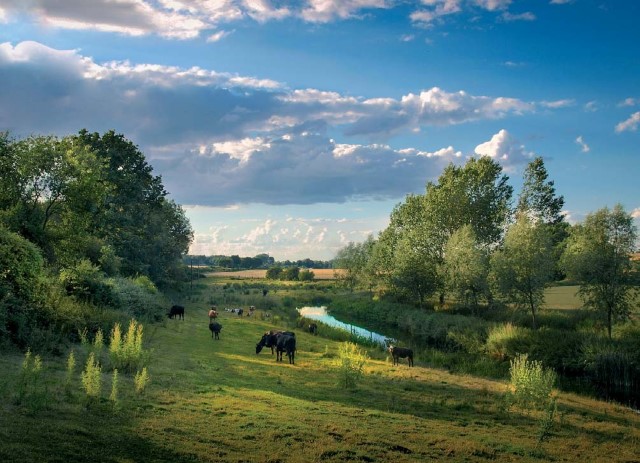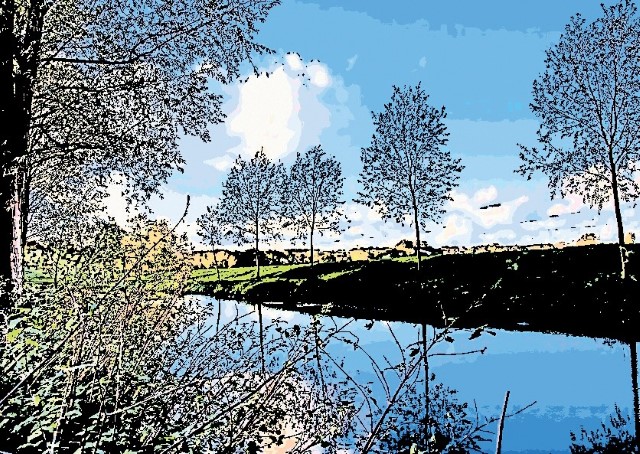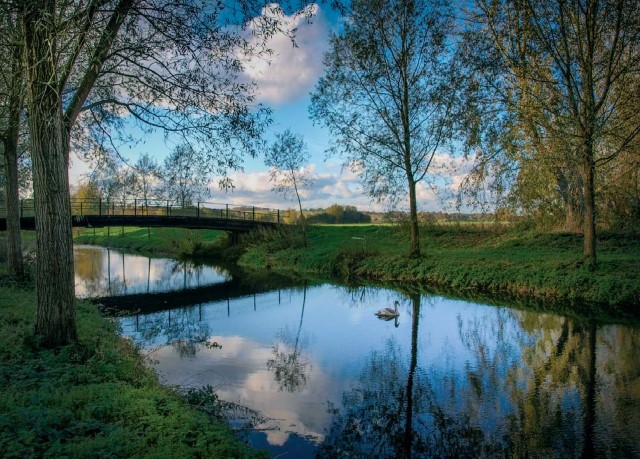UNLOCKING THE ARTIST WITHIN: FINE ART LANDSCAPE PHOTOGRAPHY

A view across the Stour Valley from Hickbush – Fine art?
Some amongst us might be alarmed at the idea of fine art photography. After all, our valleys have been and are blessed with some notably fine artists. Patrick George’s painting Hickbush (1961–5) hangs in the Tate Gallery and can be seen by Googling “Tate Hickbush”. As arrogant as my opinion might seem, I would not have been happy to produce such an image though this is probably an opinion born of ignorance. I clearly do not get the esoteric aspects of the painting though I understand a recent Prime Minister to have had this painting hung in 10 Downing Street. Clearly Mr Brown did get it. I however am happy with my image above after much faddling on my computer. Our landscape views are highly layered and that’s what I hope my picture says.
So for those of us who are not artists, this article provides a look at yet another way to engage with and enjoy our valley landscapes and go on to produce minor works of art simply to please ourselves. I should start by stating that despite the content of past articles, this one is pylon free and is more a response to my need to capture and speak of the beauty I find in the Colne and Stour valleys. I am also motivated by the sense of irony that flowed from having played a very small part in pushing for an extension to the AONB: I realised that there is a genuine dearth of high quality photography that readily speaks of why we see our valleys as outstandingly beautiful. Indeed the proposal for the extension of the AONB took the form of words – not pictures – because that was what was called for by Natural England.
A view across the Henny landscape from Hickbush – A view Patrick George must have known. The nearby tree curls around the view framing it and lending it an air of intimacy.
Having been a keen amateur photographer for over forty years I have concluded that, instead of photographing things I don’t like in support of various campaigns, I would prefer to do something more positive and try to capture and represent the loveliness of our country- side with my camera and computer. What follows is intended to be empowering. The taking of photographs teaches us to look at the world from a different perspective. Sure, you can simply take a snap that shows others what something looks like. But you can also capture an image with a view to taking it home, working on it, developing it and ending up with something that does far more, telling of your response to the landscape and what you find inspiring in it.
All of this has become possible because of the coming together of affordable technologies. Modern digital cameras, even modest ones, can capture the starting point for a beautiful image. Combine this with the software that either comes with or is cheaply installed on your computer, and you have a system for producing images that can please you and say things about your revelling in the natural beauty that surrounds us that words alone can never amply describe.
The Stour at Rodbridge
Here I was trying to get something of the feel of Gainsborough’s skies into my picture.

The Stour at Rodbridge
Now this is no technical article. If Santa brought you a nice new camera for Christmas, then you are half way toward owning the tools through which to discover the fine artist within you. I always find it easiest to learn about things that enable me to do the things I want to do. To work out what we want to do, we need inspiring. Try going online to 500px.com. There you will immediately find stunning examples of fine art landscape photography. If you think “yes, I would like to be able to do that” then go to YouTube and search “landscape photography”. Photographers such as Serge Ramily give free tutorials on processing your pictures on a computer. And there are now programs that enable you to tweak your pictures to reveal what you really feel you saw in a scene. Perhaps the most amazing aspect of all of this is that a couple of evenings tinkering and learning can have almost any of us producing quite remarkably pleasing results.
In my opinion, the best of the current generation of photo editing software is Adobe Lightroom. This provides the capability to bring out the sky, lighten the landscape, make the coloursmore rich and make all manner of other changes in an easy and intuitive way. And that’s the important bit – the software works intuitively and isn’t horribly technical.
The Stour below Lamarsh.
Processed in Lightroom the motivation for producing images like this can’t be so very different to Gainsborough’s in painting “Wooded Landscape with a Cottage and Shepherd” – available to view by Googling this title. And yes, I did edit out the man-made structures. But then, Constable painted out the owner of the little dog in The Hay Wain because it spoiled the composition. Take a close look at the painting at the National Gallery and you will see this for yourself. So there’s a strong artistic precedent for editing out the things you don’t want to look at.
There is an argument that technology democratises photography, making it possible for us all to produce something which is for ourselves, rather special and more than just reportage. Gainsborough produced landscapes for the love of it – why shouldn’t we do the same? Why shouldn’t we edit our works of art for the same reasons as Gainsborough did?
You might now ask why I think other readers want to produce inspiring images of our landscape? Well in response to my earlier call for images of the Stour Valley for a website to support the application to extend the AONB, I received, amongst other beautiful images, one of the view across to Cornard from Lamarsh. Its colours were boosted and the picture included a frame, surely a suggestion that its creator saw it as art rather than simple reportage.
I cannot paint a picture to satisfy even myself. But I can take a half decent photograph. Amongst the readership of this magazine, I feel sure I’m far from alone. Within this article are images taken around the Stour and then processed on my laptop computer to produce what you see. I claim no artistic virtue in them but some would be regarded as fine art images in the world of photography. Let me be frank, if I can do this, so can you – if you want to.
The Stour towards Bures.
Another aspect of photography that is of enormous value comes from the fact that it causes you to look at things differently. A camera puts a frame around a view. Where should the horizon be? Where should strong diagonal lines exit the picture? Should I include near objects in a distant view? These are all issues of composition just as they are for a painter. The “rule of thirds” that says you should place the horizon two thirds of the way up a picture where the landscape is the main subject and one third of the way up what is essentially a skycape is just as relevant to photography as it is to painting landscapes. The strange thing is that if you take an interest in this, you will find yourself looking for composition in views whilst out walking even when you have left your camera at home. You will also quickly learn (if you haven’t already) that just after dawn and just before sundown are magical times to explore our valleys, when the light brings special qualities to what you see no matter where you left your camera.

The Stour below Lamarsh

The Stour towards Bures. An image reduced to a cartoon like quality with inexpensive computer software.

A young swan drift gently down the Stour towards Bures.
Thomas Gainsborough captured the nature of our landscapes in a way that few cameras can. To start with, he could balance up the depth of colour in the sky and landscape lifting the shadows to provide detail and colour where the camera alone delivers blackness or a bleached out white sky. Modern digital photography brings together camera, computer and human to enable to get much closer to providing you with the ability to represent what you see, more as Gainsborough did.
A young swan drifts gently down the Stour toward Bures. My computer enabled me to darken a bleached out sky to reveal its true colours whilst at the same time allowing me to lighten the foreground, add colour to the leaves on the trees and sit the swan in a pool of light rather than hide in the shadows.
Today, we live in valley landscapes that are better maintained, better understood and perhaps more beautiful than they have been ever since photography was invented a century after Gainsborough walked our valley. We all seem to own cameras and computers these days and learning how to achieve remarkably beautiful results with them working together is just a free YouTube tutorial video away. This being so, the biggest question for me is why are there not more wonderful inspiring images of the Colne and Stour Valley landscapes washing around the internet? I guess we just enjoy it for what we find in it already. But I feel inspired to tell the world that this place is wonderful – look!
In fine art photography we have a way to speak of how we feel about our countryside as well as showing what it looks like. In photography we all have yet another way to revel in its beauty. We are all surrounded by a fabulous subject and blessed with the toys that can enable us to capture images of it that can please ourselves and perhaps inspire others. There really is no excuse for not getting out there and rejoicing in our surroundings and showing it through our own fine artistry.
David Holland
When we think of the name, David Holland, the association is with that invasive species the Pylons! David has been a leading light in opposing the next line of Pylons, which have been put on hold. However do not kid yourself, they will re-emerge, sooner than you might hope. Once again CSCA will support David and work with others to defend our fragile environment.
